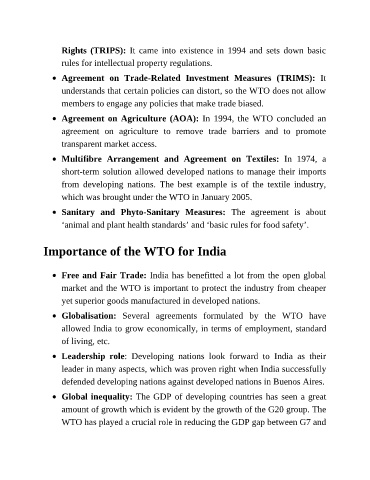Page 555 - SSB Interview: The Complete Guide, Second Edition
P. 555
Rights (TRIPS): It came into existence in 1994 and sets down basic
rules for intellectual property regulations.
Agreement on Trade-Related Investment Measures (TRIMS): It
understands that certain policies can distort, so the WTO does not allow
members to engage any policies that make trade biased.
Agreement on Agriculture (AOA): In 1994, the WTO concluded an
agreement on agriculture to remove trade barriers and to promote
transparent market access.
Multifibre Arrangement and Agreement on Textiles: In 1974, a
short-term solution allowed developed nations to manage their imports
from developing nations. The best example is of the textile industry,
which was brought under the WTO in January 2005.
Sanitary and Phyto-Sanitary Measures: The agreement is about
‘animal and plant health standards’ and ‘basic rules for food safety’.
Importance of the WTO for India
Free and Fair Trade: India has benefitted a lot from the open global
market and the WTO is important to protect the industry from cheaper
yet superior goods manufactured in developed nations.
Globalisation: Several agreements formulated by the WTO have
allowed India to grow economically, in terms of employment, standard
of living, etc.
Leadership role: Developing nations look forward to India as their
leader in many aspects, which was proven right when India successfully
defended developing nations against developed nations in Buenos Aires.
Global inequality: The GDP of developing countries has seen a great
amount of growth which is evident by the growth of the G20 group. The
WTO has played a crucial role in reducing the GDP gap between G7 and

